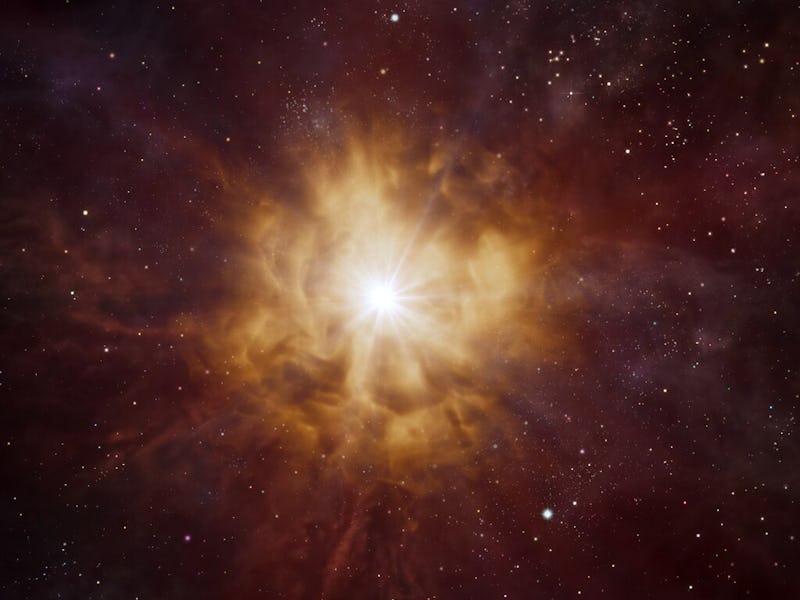Element found in human teeth discovered in distant galaxy
This marks the most distant discovery of fluorine in the universe.

The Carl Sagan quote “we’re made of star stuff” is not only poetic, but also quite accurate. All the elements found in the human body were once forged in the cosmos and can still be found lingering across the expanding universe.
Scientists recently made the most distant discovery of an element commonly found in our bones and teeth. Researchers at the European Southern Observatory detected fluorine in the large clouds of gas of a distant galaxy located 12 billion light years away, meaning the universe was only about 1.4 billion years old at the time.
The discovery helps scientists understand how fluorine is made amongst the stars and get a better estimate of the lifecycle of ancient stars.
The researchers detailed their discovery in a study published in Nature Astronomy.
WHAT’S NEW — Astronomers spotted the fluorine using the Atacama Large Millimeter/submillimeter Array, a group of 66 radio telescopes in the Atacama Desert of northern Chile.
The team had been observing a galaxy located 12 billion light-years away from Earth. But this galaxy, which is dubbed NGP–190387, was exceptionally bright because of a slight cosmic trick. Another massive galaxy is located between Earth and NGP-190387 in the same line of sight, causing the more distant galaxy to appear larger and brighter. This effect is known as gravitational lensing.
NGP–190387 is a star-forming, dusty galaxy located in the distant universe at a time when the universe was only at 10 percent of its current age.
Fluorine was spotted in the galaxy’s gas clouds in the form of hydrogen fluoride.
HERE’S THE BACKGROUND — The fluorine was likely formed in stars, and later expelled outwards into the universe when those stars died. Stars that explode in a supernova scatter their elements outward at the end of their life.
“We all know about fluorine because the toothpaste we use every day contains it in the form of fluoride,” Maximilien Franco from the University of Hertfordshire in the UK, who led the new study, said in a statement. “We did not even know which type of stars produced the majority of fluorine in the Universe!”
The recent discovery marks the most distant detection of fluorine, which had been forged when the universe was only at 10 percent of its current age (scientists estimate the age of the universe to be around 13.8 billion years old).
“For this galaxy, it took just tens or hundreds of millions of years to have fluorine levels comparable to those found in stars in the Milky Way, which is 13.5 billion years old. This was a totally unexpected result,” Chiaki Kobayashi, a professor at the University of Hertfordshire, and co-author of the new study. “Our measurement adds a completely new constraint on the origin of fluorine, which has been studied for two decades.”
That means that the stars that had formed the fluorine had a short-lived existence, having already died when the universe was only 1.4 billion years old.
The scientists believe that the fluorine was produced by a type of star known as Wolf–Rayet, which are very massive stars that live only a few million years.
“We have shown that Wolf–Rayet stars, which are among the most massive stars known and can explode violently as they reach the end of their lives, help us, in a way, to maintain good dental health!” Franco said. Fluoride is found primarily in human bones and teeth and consumed mainly with toothpaste and other dental products to promote the strength of teeth.
Fluorine had previously been detected in distant quasars, some of the brightest objects in the universe found at the center of galaxies. But this recent detection of fluorine is the first time astronomers observed this element in the clouds of a galaxy other than the Milky Way.
WHAT’S NEXT — The astronomers behind the new study are planning for future observations of the distant galaxy NGP–190387, which will allow them to peer back in time through the cosmic timeline.
They plan to use the Extremely Large Telescope, which is currently under construction in Chile and expected to launch in 2027.
“With the ELT, we will be able to observe NGP–190387 through the direct light of stars, gaining crucial information on the stellar content of this galaxy,” Chentao Yang, an ESO Fellow in Chile, said in a statement.
Abstract — Fluorine is one of the most interesting elements for nuclear and stellar astrophysics1,2 . Fluorine abundance was first measured for stars other than the Sun in 19921 , then for a handful of metal-poor stars3 , which are likely to have formed in the early Universe. The main production sites of fluorine are under debate and include asymptotic giant branch stars, the ν-process in core-collapse supernovae, and Wolf–Rayet stars4–10. Due to the difference in the mass and lifetime of progenitor stars, high-redshift observations of fluorine can help constrain the mechanism of fluorine production in massive galaxies. Here, we report the detection of HF (signal-to-noise ratio of 8) in absorption in a gravitationally lensed dusty star-forming galaxy at redshift z= 4.4 with NHF/NH2 as high as ~2 × 10−9 , indicating a very quick ramp-up of the chemical enrichment in this high-z galaxy. At z= 4.4, asymptotic giant branch stars of a few solar masses are very unlikely to dominate the enrichment. Instead, we show that Wolf–Rayet stars are required to produce the observed fluorine abundance at this time, with other production mechanisms becoming important at later times. These observations therefore provide an insight into the underlying processes driving the ramp-up phase of chemical enrichment alongside rapid stellar mass assembly in a young massive galaxy.